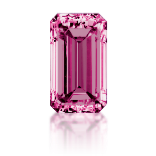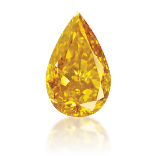
DIAMOND EDUCATION:
THE FOUR C'S

A diamond is defined by professionals and the public alike, most often by its cut. colour, clarity and carat weight contribute heavily as well to a diamond’s value and aesthetic appeal, however it’s the cut that impacts directly on the stone’s facets, proportions, and light reflection.
Light's Effect on a Diamond
There are many factors that determine a diamond’s brilliance, the most important of which is its ability to reflect light. As a diamond is moved through a light source, tiny flashes will be visible within the stone. Commonly known as sparkle, this is also referred to as scintillation, an effect of the stone’s reflection and refraction of light.

Reflection
When light enters the surface of a diamond, a portion of it is reflected back out of the top.

Refraction
The remaining rays of light travel into the center of the diamond and bounce off its internal walls, an effect known as refraction.

Dispersion
As light exits the diamond, dispersion causes the white light to be separated into multiple colours. Some light will escape out the bottom and sides, and some will reflect out of the top of the stone.
Cut Definitions
A diamond’s cut is an integral factor in determining its brilliance and fire. Even a flawless diamond will appear dull and muted if the cut is poor. When evaluating the cut of a diamond, there are some core characteristics that should be considered:

Proportions
A diamond’s proportions, a measure of the number and size of facets and its overall length and width, are integral in determining the quality of its cut. When a diamond is cut with the ideal proportions for its shape, it will reflect more light out of the top, resulting in higher levels of fire and brilliance. A poorly cut diamond with incongruous proportions will allow light to escape out the bottom and sides, resulting in a dull, dark appearance.
Depth & Depth Percentage
A diamond’s depth can be determined by measuring the entire stone’s height from the table to the culet and is described in millimeters. The depth percentage measures the ratio of the stone’s depth (from the table to the culet) to the diamond’s total diameter.
Measurements
Measured in millimeters, the measurements of a diamond’s length, width, and height are used to evaluate the symmetry and quality of its cut.
Table Percentage
A diamond’s table is the largest facet of the stone, comprising the flat surface on the top. The table percentage is the ratio is the width of the diamond’s top facet in relation to the width of the entire stone. The right ratio results in a large amount of fire and brilliance.
Cut/Shape
Round diamonds have long been the most popular, although many modern consumers prefer alternative shapes, including emerald, princess, radiant, and asscher, among others.










Diamond Components
A diamond is comprised of the following main components:


Table
This is the largest facet of the stone.
It comprises the flat surface on the top, resembling a ‘table’.

Crown
A diamond’s crown extends from the top of the stone (the ‘table’) down to the girdle (the widest point of the diamond).
Crowns can be comprised of step cut facets or brilliant cut facets.

Girdle
A diamond’s girdle can be rough, polished, or faceted, and does not typically affect the quality or appearance of the stone.
This is the portion of the diamond between the crown and the pavilion, essentially spanning the width of the
stone from side to side. The measurement of the girdle represents the perimeter of the diamond.

Pavilion
Located at the bottom of the diamond, the pavilion is integral to the stone’s light reflecting properties. A properly cut pavilion will allow the maximum amount of light to reflect from the surface of the stone.
An excessively deep or shallow diamond can cause light to escape out the bottom and sides, reducing its sparkle.

Culet
The smallest facet of a diamond, the culet is located at the very bottom of the stone. If the diamond ends in a point, the diamond grading report will show a value of ‘None’ for the culet designation.
This small facet was originally intended to protect the diamond’s pavilion, although today’s settings are usually strong enough to render it unnecessary.
Facet/Faceting
With modern diamond-cutting techniques, there are two common methods of cutting facets, each with its own unique light reflection properties:

Step-Cut Faceting
In this approach, the facets are elongated and placed in rows to simulate a mirrored staircase.

Brilliant Cut Faceting
This technique creates triangular-shaped facets that face outwards from the center of the diamond.
Other Variables
A diamond's polish and symmetry are critical to the quality of its cut.

Polish
A diamond’s ratings for symmetry, polish, and cut grade may vary based on which Gemological Laboratory is evaluating it, as each agency uses a different scale.

Symmetry
A symmetrical diamond will have well-balanced, properly aligned facets, resulting in a high level of fire and brilliance. If the facets are not symmetrical or not optimally shaped, they’ll display less sparkle.

Cut Grade
A gemologist assigns a cut grade as a means of measuring a diamond’s proportions, craftsmanship, quality of polish, and light reflecting properties. A diamond with a high quality cut grade will exude a large amount of brilliance and fire.
Cut & Value
The quality of a diamond’s cut has a significant impact on its value.
Well-Cut
A well-cut stone sacrifices more of the rough diamond during the cutting process, resulting in a higher market value. It will also exhibit better light reflecting properties, exuding greater fire and brilliance.
Improperly Cut
Improperly cut diamonds will have less visual appeal and a decreased value. To ensure the best value, look for a certified diamond with polish and symmetry ratings of ‘Good’ or better.

Shallow Cut
Although a shallow cut diamond will create the illusion of a larger stone, it allows light to escape out the sides instead of reflecting off the top, creating a lack of brilliance and sparkle.

Ideal Cut
This is the cut of a high quality diamond that beautifully reflects light. This premier cut style is well-proportioned and carefully angled to achieve a luminous appearance.

Deep Cut
This type of cut poorly reflects light, resulting in a dull, muted appearance.
Certification
A diamond certificate, also known as a diamond grading report, is an easily understood document prepared by an expert gemologist that describes the key characteristics of a diamond. Every diamond sold by Pantera Privé B.V. is certified a third-party certification laboratory such as the Gemological Institute of America (GIA).


Diamond Colors
Pale Color
Less Rare & More Affordable
Strong Color
More Rare & More Valuable


Red Diamonds
The rarest of the rare, with fewer than 80 pure natural red diamonds in the entire world. Natural reds range from dark pink hues, to purplish red. The deeper the color, the higher the value, with an average natural red around 0.20 carats, starting at around $100,000 in value.

Blue Diamonds
Blue diamonds are nearly the rarest diamonds of all, with their color being derived from boron being trapped within the structure of the diamond. One in around 200,000 diamonds contain any hint of blue, with even fewer possessing any significant depth in color.

Orange Diamonds
Orange diamonds represent an indelibly rare category of natural colors, with only a handful of pure oranges being found a year. A rare orange was sold at auction for an incredible £22 million, setting this color in a class by itself.

Pink Diamonds
Pink diamonds have long been the popular section of choice by investors and collectors worldwide, particularly Argyle diamonds, from the Argyle Mine in Australia, source of more than 90% of the world’s pinks. With the mine’s pending 2020 closure, these treasures are in higher demand than ever.

Yellow Diamonds
Less common than brown diamonds, but fairly common compared to the other natural colors, demand for yellow diamonds has increased expontentially thanks to their huge demand in China and India for engagement rings and by collectors.

Brown Diamonds
The most common of the fancy color diamonds. Up until 20 years ago they were considered valuable primarily for industrial purposes such as cutting machine blades. Their value has rocketed in recent years due to an upswing in the popularity of “chocolate” diamonds.
Diamond Carat Weight
One carat is divided into 100 points, so that a diamond of 75 points weighs 0.75 carats. The carat-weight of a diamond is the easiest measurement to determine.
As the carat weight of a diamond increases, so does its rarity and therefore it’s price and value.

Diamond Clarity
Inclusions found on a diamond can be considered nature's birthmarks, the distinguishing characteristics that make the stone unique. When grading a diamond, the amount of inclusions and blemishes has a direct impact on its clarity and value. Flawless diamonds containing no inclusions are extremely rare and very expensive. A majority of the commercially sold diamonds contains inclusions that are undetectable to the unaided eye.
To ensure a large selection, Brilliance offers diamonds with a range of clarity ratings from FL (Flawless) to I1 (Included). Diamonds with clarity ratings of I1 or higher contain inclusions that are typically undetectable without special magnified viewers.
Clarity Scale
A diamond's clarity rating is based on the size, number, and location of internal and external characteristics. Known as inclusions, internal characteristics include crystals, clouds, and feathers. External characteristics, or surface irregularities, are called blemishes. As most inclusions can't be seen by the naked eye, gemologists use a ten-power (10x) microscope to rate a diamond's clarity.

Clarity Abbreviations
FL-IF:
No internal inclusions.
VVS1 - VVS2:
Very Very Small Inclusions. Very difficult to detect under 10x magnification.
VS1 - VS2:
Very Small Inclusions. Can be seen under 10x magnification and in some cases to the naked eye.
SI1 - SI3:
Small Inclusions. Can be seen under 10x magnification and may be visible to the naked eye.
I1 - I3:
Imperfect. Inclusions are visible under 10x magnification and in most cases to the naked eye.
Selecting a Clarity
Below are some points to consider when selecting your desired clarity rating:
Those who prefer a diamond with little or no inclusions will likely choose a clarity rating of FL-IF or VVS. Although they are priced higher, these high-quality diamonds boast a near-perfect appearance.
While still considered high quality, diamonds rated in the VS clarity range will not cost as much as more premium clarities. VS diamonds will contain inclusions that are undetectable to the unaided eye.
Considered by many to be a great value, SI1-SI2 diamonds will contain inclusions that can be detected with magnification, yet are typically undetectable to the unaided eye and do not detract from the beauty of the diamond. If you are considering a diamond with an SI rating, contact a Brilliance diamond and jewelry expert to ensure the inclusions are not visible to the naked eye.
Those who desire large carat weights at lower prices may choose diamonds in the SI3-I1 clarity range. Inclusions in these stones are usually noticeable without magnification.
The location of a diamond's inclusions significantly impacts the stone's clarity rating. External and internal characteristics hidden near the side facets of a diamond detract from its beauty less than inclusions and blemishes located in the center of the diamond.